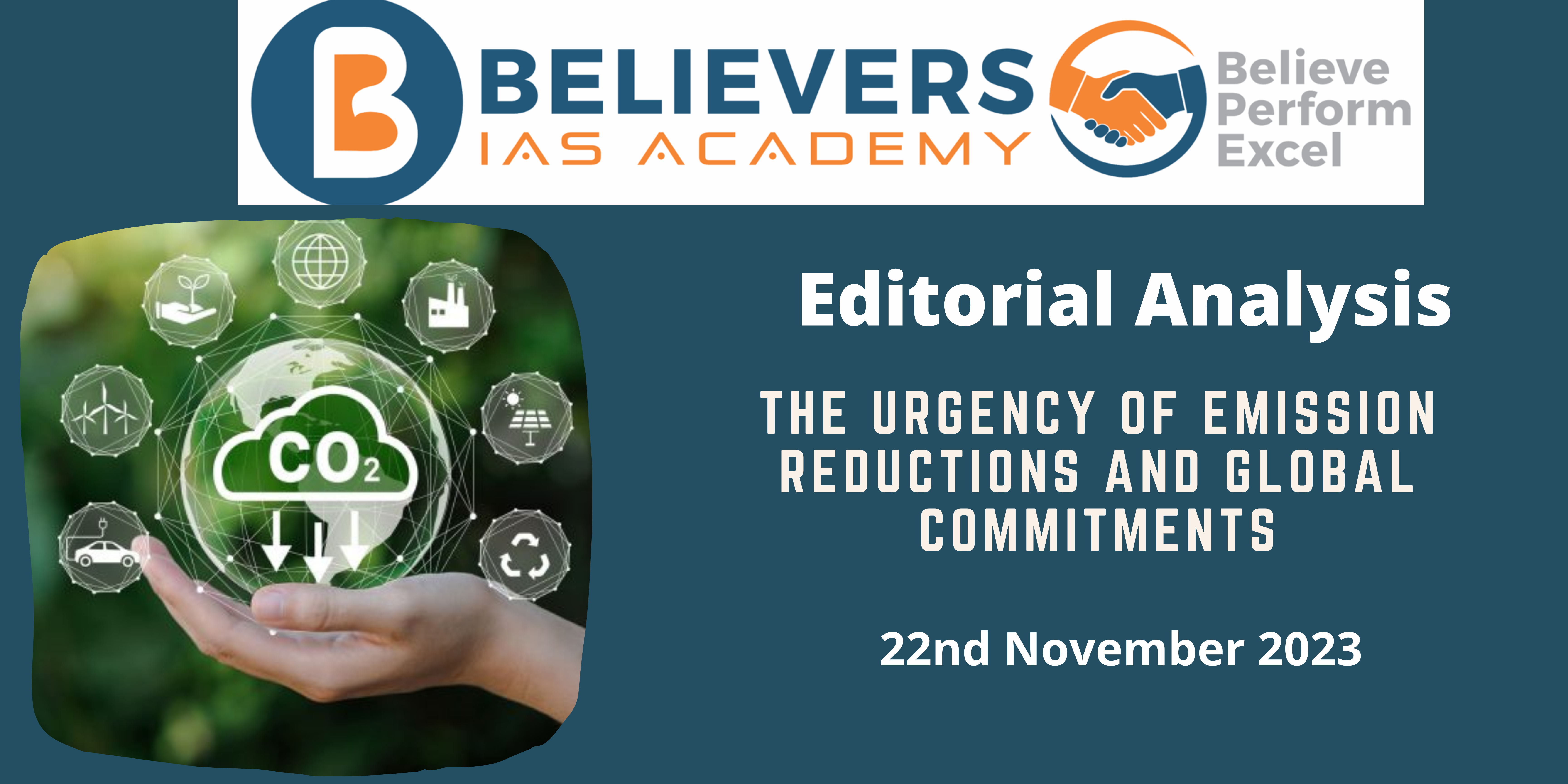The Urgency of Emission Reductions and Global Commitments
Context:
Recently, the United Nations unveiled its latest report, “Broken Record,” signaling a stark warning about the escalating threats posed by greenhouse gas emissions (GHG).
Relevance:
GS – 2, GS – 3 (Important International Institutions, Conservation, Environmental Pollution & Degradation)
Prelims:
Emission Gap Report 2022, Paris Agreement, Pandemic, GHG, COP-26, Initiatives to Reduce Emissions.
Mains Question:
What implications does the recent report on greenhouse gas emissions suggest for its reduction targets, and how credible are the promises of ‘net zero’ emissions made by various nations? (250 words)
Initiatives to Reduce Emissions in India:
- India has implemented increasingly stringent emission standards for vehicles, transitioning from BS-IV to BS-VI to curb air pollution.
- The UJALA (Unnat Jyoti by Affordable LEDs for All) scheme promotes energy efficiency by distributing LED bulbs, reducing energy consumption and carbon emissions.
- India is part of the International Solar Alliance, a coalition of countries working to harness solar energy and reduce dependence on fossil fuels.
- The NAPCC outlines India’s strategy to address climate change, focusing on adaptation and mitigation measures across various sectors.
- India aims to blend a percentage of ethanol with petrol to reduce the carbon footprint of the transportation sector.
- India updated its Nationally Determined Contributions (NDC) as part of the Paris Agreement, committing to specific actions to mitigate climate change.
United Nations Environment Programme (UNEP):
- UNEP was established on June 5, 1972.
- It serves as a global environmental authority as it sets the global environmental agenda, promotes sustainable development within the UN system, and advocates for global environmental protection.
- It is headquartered in Nairobi, Kenya.
- Major Reports: The Emission Gap Report, Adaptation Gap Report, Global Environment Outlook, Frontiers, and Invest into a Healthy Planet.
- Major Campaigns: Beat Pollution, UN75, World Environment Day, and Wild for Life.
Dimensions of the Article:
- The Unsettling Reality of Emissions Overshoot
- Net Zero Promises
- Consequences of Global Tardiness
- Climate Summits
The Unsettling Reality of Emissions Overshoot:
- The report sheds light on the disconcerting reality that, despite the Paris Agreement, countries are on track for a temperature overshoot.
- Delving into the intricacies of commitments made by nations to reduce reliance on fossil fuels, the analysis unveils a potential overshoot ranging between 2.5°C-2.9°C.
- The looming crisis necessitates a reevaluation of global efforts to curb emissions.
- A critical aspect unfolds as the report emphasizes the urgency of emission reductions. To curtail the temperature rise below 2°C, nations must slash emissions by 28% by 2030, while a more ambitious 42% reduction is required to achieve the 1.5°C target. This dimension explores the magnitude of the task at hand and the collective responsibility of nations.
Net Zero Promises:
- The report scrutinizes promises made by nations to achieve ‘net zero’ carbon emissions. Despite widespread commitments, the report casts doubt on the credibility of these assurances.
- Through a pragmatic lens, it evaluates the feasibility of achieving such ambitious targets, presenting a nuanced perspective on the global transition to sustainable practices.
- An evaluation of the effectiveness of the Paris Agreement becomes imperative. Contrary to its perceived shortcomings, the report acknowledges some progress in curbing GHG emissions. It dissects the gap between projected and actual emissions, providing insights into the challenges faced and the need for recalibrated strategies.
Consequences of Global Tardiness:
- The consequences of delayed action on a global scale come to the forefront. The article elaborates on the alarming trends, including an increase of 1.2% in global emissions in 2022, despite a temporary dip during the pandemic.
- The frequency of days exceeding 1.5°C above pre-industrial levels underscores the urgency of transformative measures.
- Solutions proposed in the report echo age-old advice, emphasizing the imperative for the wealthiest nations and historical contributors to commit to more substantial and faster reductions. This section explores the urgency of a collective response and the potential ramifications of continued delays in global cooperation.
Climate Summits:
- The dynamics of climate summits, often mired in legal intricacies and detailed negotiations, are dissected.
- The urgency of the situation becomes apparent, highlighting the need for a departure from nit-picking and legal complexities to a more action-oriented approach.
- The impending deadline for global unity and decisive action forms a pivotal aspect of this dimension.
Way Forward:
The International community must acknowledge the urgency of the situation and transcend previous limitations. The report serves as a clarion call for unprecedented commitments, emphasizing the need for tangible and immediate actions to address the climate crisis.


